- ABASED
- 1) In vexillology a term that can be used when a shield or emblem is not centred on
the horizontal meridian of the flag or panel/canton it occupies, but placed in a lower
position– see ‘canton 2)’. ‘centred’, ‘emblem’, ‘meridian’ and shield 1)’.
2) The heraldic term for when a chevron, fesse or other ordinary, is borne lower than its
usual situation – see ‘ordinary’ and the note below.
![[abased example]](../images/v/vxt-d5338.gif)
![[abased example]](../images/v/vxt-d5339.gif)

Flag of Vaulruz, Switzerland (fotw);
Arms of Edt bei Lambach, Austria (Wikipedia);
Flag of Olszyna, Poland (fotw)
Please note that when charges, other than the ordinaries referred above, are placed low down on the shield or banner of arms are said to be in base – see ‘in base’.
- ABATEMENTS
- A heraldic term that covers the various symbols of disgrace appearing on (or disfiguring) the arms of those guilty of a dishonourable act – staynande colours (see also ‘stains’ and ‘coward’ with their following notes).
![[abatement]](../images/v/vxt-d4159.gif)
![[abatement]](../images/v/vxt-d4160.gif)
![[abatement]](../images/v/vxt-d4161.gif)
Examples (internationalheraldry.com)
Notes
1) There is no evidence that these symbols were anything other than theoretical, and in addition:
2) A detailed description of them is beyond the remit of this Dictionary, so the Editors suggest that a suitable work on heraldry be consulted if further information is required
- ABEYANCE
- See ‘in abeyance’.
![[abeyance]](../images/v/vxt-d1914.gif)
Former First Class Commodore’s Broad Pennant, UK (fotw)
- ABOVE
- 1) In vexillology a term used when a charge (or charges) is (or are) placed
at
the top of, or immediately above
another – but see ‘above 2)’ and ‘surmounted by 1)’ (also
‘charge 1)’).
2) In heraldry, see ‘ensigned’.
![[above]](../images/v/vxt-d2205.gif)
![[above]](../images/v/vxt-d2728.gif)
![[above]](../images/v/vxt-d4305.gif)
National Flag of Zambia (fotw); National Flag of
Malawi (fotw);
State Flag of Hungary (fotw)
- ABSENCE PENNANT (or ABSENTEE PENNANT)
- 1) In widespread naval usage, one of four pennants (the first to the fourth
substitute in the NATO Code of Signals) displayed (from the port or starboard yardarm) in
port when the commanding officer of a ship
or the flag officer or civil official whose flag has been flying in that ship is temporarily
absent from the vessel (see also
'international code of signal flags’,
‘international code of signals’ and
‘substitute’).
- 2) See ‘owner absent flag’.
![[absence example]](../images/v/vxt-d008a.gif)
![[absence example]](../images/v/vxt-d008b.gif)
![[absence example]](../images/v/vxt-d008c.gif)
![[absence example]](../images/v/vxt-d008d.gif)
First Substitute (Flag Officer Absent),
Second Substitute (Chief of Staff Absent), Third Substitute (Captain Absent),
Fourth Substitute (Civil/Military Official Absent) (fotw)
- ACCOLÉ
- An alternative heraldic term to gorged - see ‘gorged’.
![[accolle example]](../images/v/vxt-d5448.gif)
![[accolle example]](../images/v/vxt-d4679.gif)
![[accolle example]](../images/v/vxt-d029.gif)
Flag of Chénens, Switzerland (fotw);
Flag of Ourém, Portugal (fotw);
Flag of Elgg, Switzerland (fotw)
- ACCORNÉ
- An alternative heraldic term to attired - see ‘attired’.
![[accorne example]](../images/v/vxt-d031.gif)
![[accorne example]](../images/v/vxt-d031a.gif)
Flag and Arms of Blížejov, Czechia (fotw)
- ACCRETION
- A term sometimes used by textile experts involved in fabric conservation,
and describes the soiling, mildew damage or other defects that occur on the surface
of a flag.
- ACHIEVEMENT (OF ARMS)
- 1) In heraldry see ‘armorial bearings’.
- 2) In strict heraldic practice all the armorial bearings of a deceased person as displayed at that person’s
funeral – a funeral achievement or hatchment (see also
‘armorial bearings’,
‘badge banner’,
‘bannerole’,
‘coat of arms’,
‘great banner’
and ‘grumphion’).
![[Barbados arms]](../images/v/vxt-d3189.gif)
![[Bahamas arms]](../images/v/vxt-d2276.gif)
![[Churchill arms]](../images/v/vxt-d890.gif)
Achievement of Arms/Armorial Bearings of Barbados
and of Guyana (fotw); Achievement of Arms/Armorial Bearings of the Late Sir Winston Churchill, UK
(Churchill Society)
Please note with regard to 2) that if all the armorial bearings of a deceased person are displayed on a
flag they become a great banner, or if less than all a bannerole, both as referenced above.
- ACHROME
- The French for colourless – but see ‘monochrome 1)’.
![[achrome example]](../images/v/vxt-d2063.gif)
Achromatic Illustration of 1993 (Tomislav Todorovic)
- ACORN (or ACORNED) CROSS
- In largely South European heraldry, the alternative terms used to describe a Greek
Cross adorned with acorns, and symbolic of St Anthony in the Portuguese
tradition – a term, as far as can be discovered, unknown in English heraldry
(See also ‘cross tau’
and ‘Greek cross’).
![[acorn example]](../images/v/vxt-d3592a.gif)
![[acorn example]](../images/v/vxt-d3593.gif)
![[acorn example]](../images/v/vxt-d3593a.gif)
Arms of
Armação de Pêra, Portugal (fotw); Flag and Arms of
Santo António dos Cavaleiros e Frielas, Portugal (fotw)
- ACTION PENNANT
- See ‘paying off pennant’.
- ACTIVE
- In vexillology a term that may be used to describe when the rays
of a star or sun emblem, or a radiating stripe, are shown with undulating or wavy curves – see
‘active and inactive’ below and
‘inactive’
(also ‘radiating’,
‘rays 1)’,
‘star’ and its following note,
‘sunburst’,
‘sun emblem’ and
‘wavy’).
![[active example]](../images/v/vxt-d553.gif)
![[active example]](../images/v/vxt-d2062.gif)
![[active example]](../images/v/vxt-d1730.gif)
National
Flag of Kyrgyzstan (fotw);
Unofficial Flag of Guadeloupe (fotw);
Flag of Pernambuco, Brazil (fotw)
- ACTIVE AND INACTIVE
- In vexillology a term that may be used to describe when the rays of a star or sun
emblem are shown with alternating wavy and straight rays – but see
‘sun-in-splendour’
(also ‘active’ above,
‘inactive’,
‘rays 1)’,
‘star’ and its following note,
‘sunburst’,
‘sun emblem’ and
‘wavy’).
![[Active/Inactive example]](../images/v/vxt-d2001.gif)
![[Active/Inactive]](../images/v/vxt-d564a.gif)
![[Active/Inactive example]](../images/v/vxt-d2002.gif)
National Flag of
Argentina (fotw); National Emblem and Flag of
Uruguay (fotw)
- ADDITION(S) OF HONOUR (or HONOR)
- See ‘augmentation of honour’.

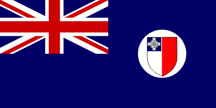
Arms and Government Ensign of Malta 1943 - 1964 (fotw)
- ADDORSED
- 1) The heraldic term used when two animals are turned back to back – endorsed – but see 2) below and ‘averted’.
- 2) The heraldic term also used when two charges are turned outwards – endorsed (see also
‘charge 1)’).
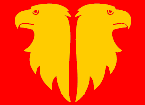


Former Flag of Aure, Norway (fotw);
Flag of Mattstetten, Switzerland (fotw);
Flag of Ferrette, France (fotw)
- ADDRESS GROUP
- In US naval usage and in some others, the group of signal flags displayed by a vessel with
a flag officer or unit commander embarked, and flown (together with a call sign hoist) when
entering or leaving harbour – see
‘call sign hoist’
(also ‘signal flag’ and
‘signal hoist’).
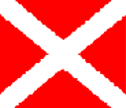

Address Group of the Commander, Second Fleet, US (Sea Flags)
- ADMIRAL'S FLAG
- See ‘flag of command 1)’.


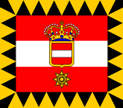
Command Flags of an Admiral, Vice-Admiral, and Rear-Admiral, Austria-Hungary 1894 – 1915 (fotw)
- ADMIRALTY CROWN
- In UK usage an alternative term for the naval crown - see ‘naval crown’.
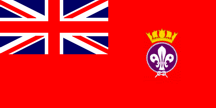

Flag and Badge of the Sea Scouts, UK (fotw & official website)
- ADMIRALTY FLAG
- 1) Specifically in UK usage see ‘anchor flag 2)’
(also ‘fouled anchor’).
2) Generically the flag, usually (but not exclusively) flown ashore, which represents a maritime authority
(see also ‘state ensign 2)’).
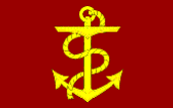
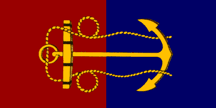

Flag of the Admiralty Board, UK (fotw);
Flag of the Naval Board, New Zealand (fotw); Flag of the Admiralty;
Thailand (fotw)
- ADMIRALTY WARRANT
- See ‘warrant’ and its following note.
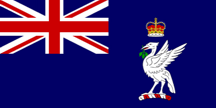
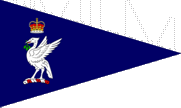
Ensign and Burgee of the Royal Mersey Yacht Club, UK (fotw)
- ADMIRAL WITHOUT DISTINCTION OF COLOUR
- See ‘yellow admiral’.
- ADORNED
- 1) In heraldry see ‘garnished’.
2) The heraldic term that may also be used in place of garnished when a hat, or other
item of clothing is usually (but not invariably) decorated in a different tincture (see also ‘tincture’
and ‘vested’).
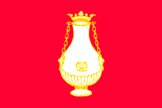
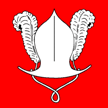

Flag of Vlissingen, The Netherlands (fotw);
Flag of Winikon, Switzerland (fotw);
Flag of Múrias, Portugal
- ADVANCE THE COLOUR/COLOURS (or COLOR/COLORS)
- (v) A military term originally for moving a flag forward towards an enemy,
and now used on ceremonial occasions as a command to parade the colour(s) forward
(see also ‘colour 2)’,
‘colours 2)’, and
‘parade flag’).
- ADVENT CROSS
- In heraldry see ‘cross tau’.

Flag of St. Antönien-Ascharina,
Switzerland (fotw)
- ADVERTISING BANNER
- See ‘banner 5)’.
![[advertising banner]](../images/v/vxt-d577.gif)
- ADVERTISING PULLDOWN (or PULL-DOWN)
- See ‘pulldown’.
![[abased example]](../images/v/vxt-d5338.gif)
![[abased example]](../images/v/vxt-d5339.gif)

![[abatement]](../images/v/vxt-d4159.gif)
![[abatement]](../images/v/vxt-d4160.gif)
![[abatement]](../images/v/vxt-d4161.gif)
![[abeyance]](../images/v/vxt-d1914.gif)
![[above]](../images/v/vxt-d2205.gif)
![[above]](../images/v/vxt-d2728.gif)
![[above]](../images/v/vxt-d4305.gif)
![[absence example]](../images/v/vxt-d008a.gif)
![[absence example]](../images/v/vxt-d008b.gif)
![[absence example]](../images/v/vxt-d008c.gif)
![[absence example]](../images/v/vxt-d008d.gif)
![[accolle example]](../images/v/vxt-d5448.gif)
![[accolle example]](../images/v/vxt-d4679.gif)
![[accolle example]](../images/v/vxt-d029.gif)
![[accorne example]](../images/v/vxt-d031.gif)
![[accorne example]](../images/v/vxt-d031a.gif)
![[Barbados arms]](../images/v/vxt-d3189.gif)
![[Bahamas arms]](../images/v/vxt-d2276.gif)
![[Churchill arms]](../images/v/vxt-d890.gif)
![[acorn example]](../images/v/vxt-d3592a.gif)
![[acorn example]](../images/v/vxt-d3593.gif)
![[acorn example]](../images/v/vxt-d3593a.gif)
![[active example]](../images/v/vxt-d553.gif)
![[active example]](../images/v/vxt-d2062.gif)
![[active example]](../images/v/vxt-d1730.gif)
![[Active/Inactive example]](../images/v/vxt-d2001.gif)
![[Active/Inactive]](../images/v/vxt-d564a.gif)
![[Active/Inactive example]](../images/v/vxt-d2002.gif)






















![[achrome example]](../images/v/vxt-d2063.gif)
![[advertising banner]](../images/v/vxt-d577.gif)